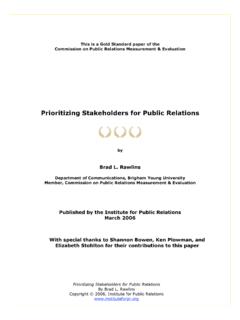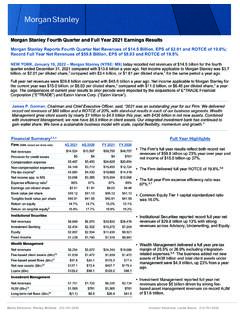Transcription of INTERNATIONAL ISO STANDARD 26000
1 Reference numberISO 26000 :2010(E) ISO 2010 INTERNATIONAL STANDARD ISO26000 First edition2010-11-01 Guidance on social responsibility Lignes directrices relatives la responsabilit soci tale ! " #$%&'()*+(,'$-(%+(./0,1(,+0%2'*+(0%'3.(4 5(,%2'6$+5,$7*5$0%.%(580,9$%&2%605:(,*+( +1,0:$7$5(6 ISO 26000 :2010(E) PDF disclaimer This PDF file may contain embedded typefaces. In accordance with Adobe's licensing policy, this file may be printed or viewed but shall not be edited unless the typefaces which are embedded are licensed to and installed on the computer performing the editing. In downloading this file, parties accept therein the responsibility of not infringing Adobe's licensing policy. The ISO Central Secretariat accepts no liability in this area. Adobe is a trademark of Adobe Systems Incorporated.)))))))))))
2 Details of the software products used to create this PDF file can be found in the General Info relative to the file; the PDF-creation parameters were optimized for printing. Every care has been taken to ensure that the file is suitable for use by ISO member bodies. In the unlikely event that a problem relating to it is found, please inform the Central Secretariat at the address given below. COPYRIGHT PROTECTED DOCUMENT ISO 2010 All rights reserved. Unless otherwise specified, no part of this publication may be reproduced or utilized in any form or by any means, electronic or mechanical, including photocopying and microfilm, without permission in writing from either ISO at the address below or ISO's member body in the country of the requester. ISO copyright office Case postale 56 CH-1211 Geneva 20 Tel.
3 + 41 22 749 01 11 Fax + 41 22 749 09 47 E-mail Web Published in Switzerland ii ISO 2010 All rights reserved ;<=>?@ABC@D?<E@=C@FGHDI@DCH=J?BC@H=?KF@LM@D=J?N<CMD<OBM<H=F=@MPHDQ<=>J=NHMR@DBC@CIDHR<O<M@NISO 26000 :2010(E) ISO 2010 All rights reserved iii Contents Page Foreword .. v vi 1 Scope .. 1 2 Terms and definitions .. 2 3 Understanding social responsibility .. 5 The social responsibility of organizations: Historical background .. 5 Recent trends in social 5 Characteristics of social responsibility .. 6 The state and social 9 4 Principles of social responsibility .. 10 General .. 10 10 Transparency .. 10 Ethical 11 Respect for stakeholder interests .. 12 Respect for the rule of law .. 12 Respect for INTERNATIONAL norms of behaviour .. 13 Respect for human rights .. 13 5 Recognizing social responsibility and engaging stakeholders.
4 14 General .. 14 Recognizing social responsibility .. 14 Stakeholder identification and 16 6 Guidance on social responsibility core 19 General .. 19 Organizational governance .. 21 Human rights .. 23 Labour 33 The 40 Fair operating 48 Consumer 51 Community involvement and development .. 60 7 Guidance on integrating social responsibility throughout an organization .. 69 General .. 69 The relationship of an organization's characteristics to social responsibility .. 69 Understanding the social responsibility of an 70 Practices for integrating social responsibility throughout an organization .. 74 Communication on social responsibility .. 76 Enhancing credibility regarding social 78 Reviewing and improving an organization's actions and practices related to social responsibility .. 80 Voluntary initiatives for social 82 Annex A (informative) Examples of voluntary initiatives and tools for social 85 Annex B (informative) Abbreviated terms.
5 98 99 STUVWXYZ[X\WT]XU[X^_`\aX\[`UbWZ[X`UWc^Xd eX\UbWfT[e\TgZeT`U^UXeh`\iTUVbUf`ejX\Z[X [a\`jTgTeXfISO 26000 :2010(E) iv ISO 2010 All rights reserved Figures Figure 1 Schematic overview of ISO Figure 2 Relationship between an organization, its stakeholders and society .. 15 Figure 3 The seven core subjects .. 20 Figure 4 Integrating social responsibility throughout the organization .. 69 Boxes Box 1 Summary information to assist users of this INTERNATIONAL STANDARD ..x Box 2 Gender equality and social responsibility .. 7 Box 3 ISO 26000 and small and medium-sized organizations (SMOs) .. 8 Box 4 Understanding 13 Box 5 Benefits of social responsibility for an organization .. 20 Box 6 The INTERNATIONAL Bill of Human Rights and the core human rights instruments .. 23 Box 7 Child labour .. 32 Box 8 The INTERNATIONAL Labour Organization.]]]]]]
6 33 Box 9 Joint labour-management health and safety committees .. 40 Box 10 Examples of climate change adaptation 46 Box 11 UN Guidelines for Consumer 52 Box 12 Consumer dispute resolution .. 58 Box 13 Millennium Development Goals .. 62 Box 14 Contributing to community development through an organization's core activities .. 63 Box 15 Reporting on social responsibility .. 77 Box 16 Certifiable initiatives and initiatives connected to commercial or economic interests .. 84 Box 17 Non-endorsement of initiatives by ISO .. 86 STUVWXYZ[X\WT]XU[X^_`\aX\[`UbWZ[X`UWc^Xd eX\UbWfT[e\TgZeT`U^UXeh`\iTUVbUf`ejX\Z[X [a\`jTgTeXfISO 26000 :2010(E) ISO 2010 All rights reserved v Foreword ISO (the INTERNATIONAL Organization for Standardization) is a worldwide federation of national standards bodies (ISO member bodies). The work of preparing INTERNATIONAL Standards is normally carried out through ISO technical committees.]]]]]]
7 Each member body interested in a subject for which a technical committee has been established has the right to be represented on that committee. INTERNATIONAL organizations, governmental and non-governmental, in liaison with ISO, also take part in the work. ISO collaborates closely with the INTERNATIONAL Electrotechnical Commission (IEC) on all matters of electrotechnical standardization. INTERNATIONAL Standards are drafted in accordance with the rules given in the ISO/IEC Directives, Part 2. The main task of technical committees is to prepare INTERNATIONAL Standards. Draft INTERNATIONAL Standards adopted by the technical committees are circulated to the member bodies for voting. Publication as an INTERNATIONAL STANDARD requires approval by at least 75 % of the member bodies casting a vote.
8 Attention is drawn to the possibility that some of the elements of this document may be the subject of patent rights. ISO shall not be held responsible for identifying any or all such patent rights. ISO 26000 was prepared by ISO/TMB Working Group on Social Responsibility. This INTERNATIONAL STANDARD was developed using a multi-stakeholder approach involving experts from more than 90 countries and 40 INTERNATIONAL or broadly-based regional organizations involved in different aspects of social responsibility. These experts were from six different stakeholder groups: consumers; government; industry; labour; non-governmental organizations (NGOs); and service, support, research, academics and others. In addition, specific provision was made to achieve a balance between developing and developed countries as well as a gender balance in drafting groups.
9 Although efforts were made to ensure balanced participation of all the stakeholder groups, a full and equitable balance of stakeholders was constrained by various factors, including the availability of resources and the need for English language skills. STUVWXYZ[X\WT]XU[X^_`\aX\[`UbWZ[X`UWc^Xd eX\UbWfT[e\TgZeT`U^UXeh`\iTUVbUf`ejX\Z[X [a\`jTgTeXfISO 26000 :2010(E) vi ISO 2010 All rights reserved Introduction Organizations around the world, and their stakeholders, are becoming increasingly aware of the need for and benefits of socially responsible behaviour. The objective of social responsibility is to contribute to sustainable development. An organization's performance in relation to the society in which it operates and to its impact on the environment has become a critical part of measuring its overall performance and its ability to continue operating effectively.]]]]]]
10 This is, in part, a reflection of the growing recognition of the need to ensure healthy ecosystems, social equity and good organizational governance. In the long run, all organizations' activities depend on the health of the world's ecosystems. Organizations are subject to greater scrutiny by their various stakeholders. The perception and reality of an organization's performance on social responsibility can influence, among other things: its competitive advantage; its reputation; its ability to attract and retain workers or members, customers, clients or users; the maintenance of employees' morale, commitment and productivity; the view of investors, owners, donors, sponsors and the financial community; and its relationship with companies, governments, the media, suppliers, peers, customers and the community in which it operates.



